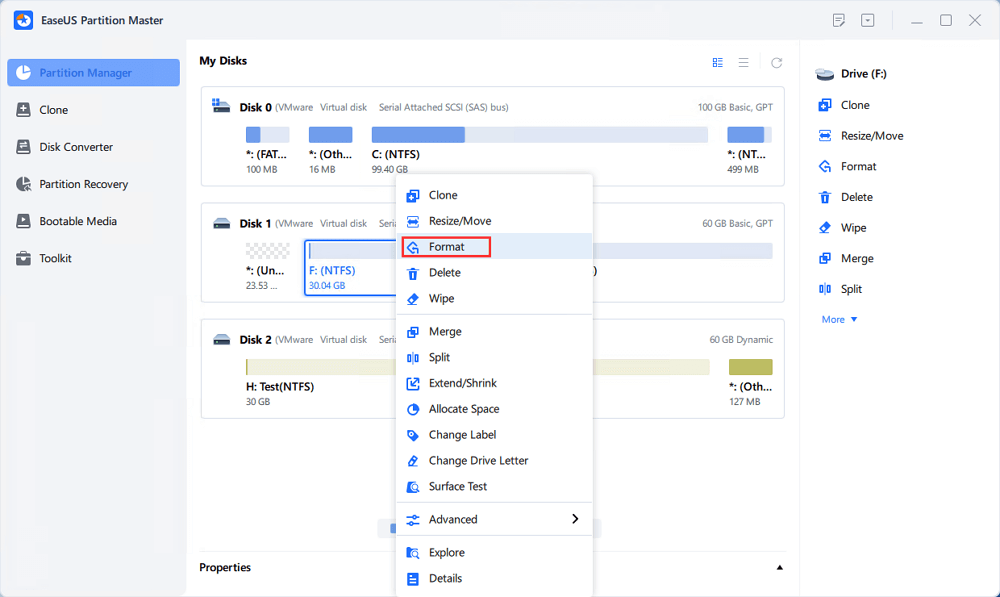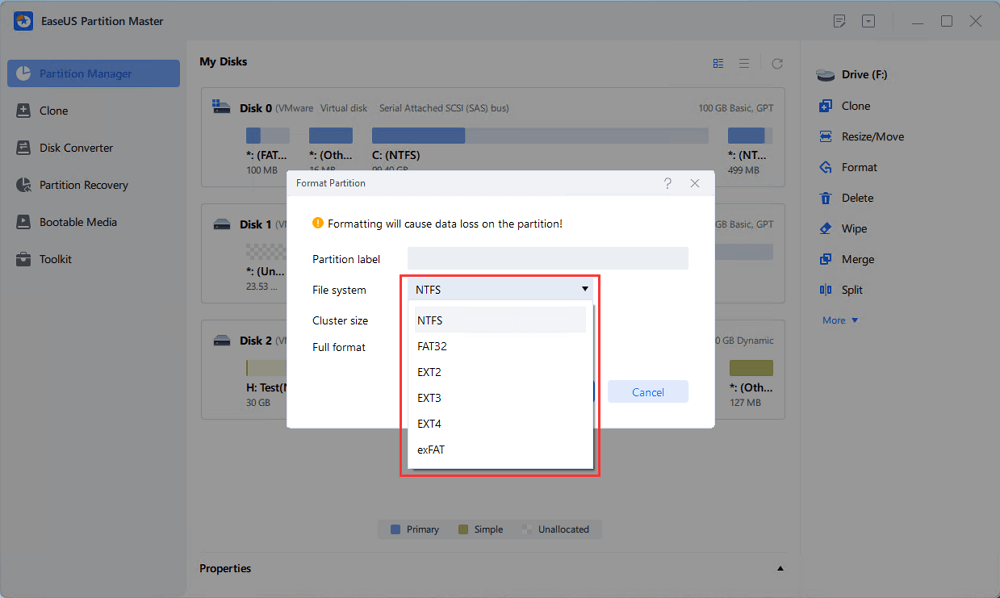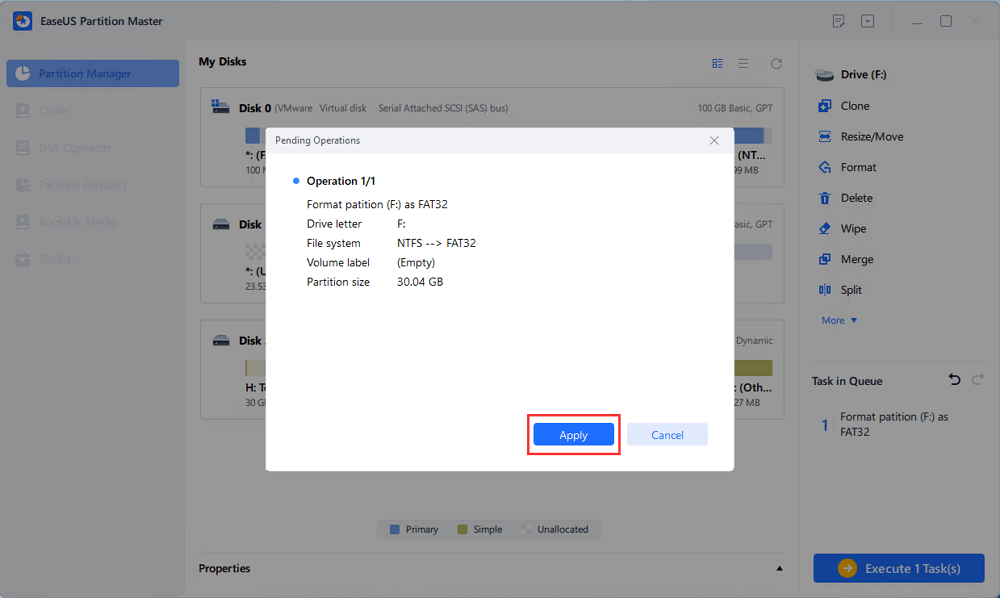Page Table of Contents
How to Bypass the BitLocker Recovery Key Blue Screen - 6 WaysHOT
Why Does the BitLocker Recovery Key Blue Screen Happen?HOT
ConclusionHOT
FAQs About How to Bypass BitLocker Recovery Key Blue ScreenHOT
About the Author
Hot Topics
Updated on Apr 01, 2025
As we know, BitLocker stands out as a built-in protection feature that helps protect data by encrypting the entire drive. However, sometimes, users may encounter the dreaded blue screen prompting them for a BitLocker recovery key. This situation usually arises when there are changes in the system's hardware or software that BitLocker considers a potential security risk.
Other than that, system updates or unexpected drive modifications can be the primary cause of this issue. Throughout this article, EaseUS will explore effective solutions for bypassing BitLocker recovery key blue screen issues and regain access to your computer. After understanding the causes and employing the proper methods, users can overcome this problem without data loss or system reinstallation.
How to Bypass the BitLocker Recovery Key Blue Screen - 6 Ways
After a basic introduction to this common error, let's move forward to find out the best solutions you can try to bypass this problem. After thorough research, we have compiled the top methods users can apply to learn how to bypass the BitLocker recovery key blue screen.
- Way 1. Disable BitLocker Encryption via EaseUS Partition Master
- Way 2. Enter the Recovery Key
- Way 3. Using Command Prompt
- Way 4. Suspend BitLocker Protection
- Way 5. Update BIOS/UEFI Firmware
- Way 6. Switch to Legacy Boot Mode
Way 1. Disable BitLocker Encryption via EaseUS Partition Master
Being one of the top disk management tools, EaseUS Partition Master Professional can help users solve various BitLocker issues, including the frustrating BitLocker recovery key blue screen.
Firstly, through this tool, you can create a bootable partition manager USB, bypass the blue screen, and apply its "Turn Off" Bitlocker encryptions feature.
Stage 1. Make Bootable Device
Step 1. To create a bootable disk of EaseUS Partition Master, you should prepare a storage media, like a USB drive, flash drive or a CD/DVD disc. Then, correctly connect the drive to your computer.
Step 2. Launch EaseUS Partition Master, and find the "Bootable Media" feature on the left. Click on it.
Step 3. You can choose the USB or CD/DVD when the drive is available. However, if you do not have a storage device at hand, you can also save the ISO file to a local drive, and later burn it to a storage media. Once made the option, click the "Create" button to begin.
- Check the Warning message and click "Yes".
Step 4. When the process finishes, you'll see a pop up window, asking if you want to restart computer from the bootable USB.
- Reboot Now: it means you want to restart the current PC and enter EaseUS Bootable Media to manage your disk partitions without OS.
- Done: it means you don't want to restart the current PC but to use the bootable USB on a new PC.

Note: To use the bootable disk on a new PC, you need to resart the target computer and press F2/F8/Del key to enter BIOS, and set the USB bootable disk as the first boot disk.
Wait patitiently and your computer will automatically boot up from the USB bootable media and enter EaseUS WinPE desktop.

Stage 2. Turn Off Bitlocker
Step 1. Open EaseUS Partition Master and right-click on the BitLocker-encrypted drive.
Step 2. Select "BitLocker Manager," and you will see a new window that allows you to perform BitLocker-relevant ops.

Step 3. Click on "Turn Off" for your target drive and wait patiently till it's done.

Secondly, you can format the encrypted partitions to remove the encryption settings. Traditional approaches often involve complex command-line steps or risky system modifications that could lead to data loss. In contrast, this software allows you to resolve the issue with just a few clicks, making the process much quicker and more reliable.
🚩Important: This process will format and wipe your disk, ensure to make a full backup before proceeding.
Step 1. Run EaseUS Partition Master, right-click the hard drive partition you intend to format and choose "Format".

Step 2. In the new window, set the Partition label, File system (NTFS/FAT32/EXT2/EXT3/EXT4/exFAT), and Cluster size for the partition to be formatted, then click "OK".

Step 3. Then you will see a warning window, click "Yes" in it to continue.

Step 4. Click the "Execute 1 Task(s)" button to review the changes, then click "Apply" to start formatting the partition on your hard drive.

Once you have gone through these advantages, you will be compelled to try out the features of this tool to get rid of this issue. So, follow the steps below to learn how to bypass the BitLocker recovery key blue screen using EaseUS Partition Master.
Other Key Features
- Check blue screen codes/logs
- Besides this issue, this tool can boot your computer when facing the blue screen of a death problem: fix Unexpected Store Exception BSOD error
- Unlock BitLocker drive Without a Recovery Key and Password
- This tool lets you recover essential data from the encrypted partitions within a few clicks
- Recover forgotten BitLocker password
Way 2. Enter the Recovery Key
When you know the BitLocker passkey, the process becomes easier than ever, as you just have to put the key in the designated box. This encryption feature lets you store or print the key for future use cases while setting up the BitLocker protection. If you misplaced this key, follow the instructions below to learn how to bypass the BitLocker recovery key blue screen.
Step 1. Once you reach the blue screen of the BitLocker recovery key, you only need to press "Esc" on your keyboard to proceed.

Step 2. Moving forward, you will reach a new screen where you can extract the recovery key ID. Now, note down this ID and provide it to your system administrator to let him find the right key from the Active Directory (AD).

Way 3. Using Command Prompt
Users who get a failure while locating their recovery key can try out the command prompt method to remove the BitLocker protection. Applying this method will require a technical knowledge of commands and their implications, so you need to have some expertise before applying this method. Even if you are a beginner, take guidance from the simplified steps to understand how to bypass the BitLocker recovery key blue screen:
Step 1. Initiate this task by pressing the "Esc" key while on the blue screen of BitLocker encryption. Hit the "Skip this Drive" option from the newly accessed window to reach the troubleshooting screen.

Step 2. After entering this screen, press "Advanced Options" to get your hands on a new set of settings. Now, tap the "Command Prompt" feature to proceed with this operation.

Step 3. Once you reach the Command Prompt window, enter the "manage-bde -unlock C: -rp" prompt to decrypt the BitLocker drive. Moving forward, write "manage-bde -protectors -disable C:" and tap the "Enter" key to remove BitLocker Protectors from your system drive.

Way 4. Suspend BitLocker Protection
If you want to bypass the BitLocker recovery key prompt and prevent it from appearing, you can temporarily suspend BitLocker protection. Suspending this feature keeps the drive encrypted but turns off the need for a recovery key until protection is resumed.
Once the BitLocker blue screen issue is resolved, users can re-enable protection to keep their data secure. With the help of the steps below, anyone can learn to resolve this annoying problem:
Step 1. First, enter "Control Panel" through the "Start" menu from the bottom taskbar to get things started. From this screen, tap on the "BitLocker Drive Encryption" option to reveal the relevant settings on your PC.

Step 2. Within the next window, press the "Suspend Protection" option to temporarily prevent the BitLocker Protection feature from interfering.

Way 5. Update BIOS/UEFI Firmware
While learning how to bypass the BitLocker recovery key blue screen, updating the BIOS to the latest version can resolve this issue. As we know, if BIOS becomes outdated or encounters a problem, BitLocker may mistakenly detect changes in the hardware configuration as a potential security threat. So, applying the following steps will address underlying compatibility issues or firmware bugs that trigger BitLocker recovery mode:
Step 1. Commence this operation task by entering the Command Prompt and typing the "wmic bios get smbiosbiosversion" to identify the BIOS in use.

Step 2. Once you have learned the model type, enter the "System Information" window by entering the "msinfo32" prompt within the "Run" dialog box. From here, you can get information about your desired BIOS version and its release date.

Step 3. After getting the information mentioned above, download the latest BIOS updates from the manufacturer's support page. The process will somehow change based on your PC's manufacturer and the current BIOS version, so search for the appropriate link. A quick online search combining the manufacturer's name with terms like "BIOS update" or "UEFI update" usually helps you find the right page.

Step 4. Upon downloading the BIOS update from the manufacturer's website, you'll typically need to extract the files. To do so, open the ZIP file and make it accessible by tapping the "Extract all" option. Afterward, users need to pick the destination folder to save the files automatically.
Step 5. Before transferring the extracted files, you need to format your USB drive. Insert the drive and right-click on its name to select "Format." Ensure the "File System" is set to FAT32. Once the drive is ready, copy and paste the downloaded BIOS file.

Step 6. Once you have copied the files, click the "Start" button and choose "Restart" from the "Power" menu. As the computer restarts, press the BIOS key assigned by your computer or motherboard manufacturer, such as F1, F12, Del, or Esc.

Step 7. Upon reaching the BIOS screen, enter the "Boot" tab to ensure your USB drive is recognized and enable any backup options.

Moving forward, access the "Advanced" tab from the top menu and choose "USB configuration." From here, you must select the option to start the BIOS update process. Once completed, your computer should automatically restart to resolve the BitLocker blue screen issue.

Way 6. Switch to Legacy Boot Mode
When you change the boot mode to UEFI, BitLocker may require a recovery key. If you're facing this issue and need to revert to Legacy mode, you'll need to access your computer's BIOS settings.
Once there, you can change the boot mode back to Legacy, which may help resolve the problem. Follow the instructions explained here to know how to bypass the BitLocker recovery key blue screen:
Instructions: Upon restarting your computer, quickly press the "F12" or any other designated key to enter the BIOS screen. From the top menu, enter the "Boot" tab to tap on the "UEFI/BIOS Boot Mode" option. Doing so will open a new dialog box from which you must choose the "Legacy" option. Once you make this selection, tap "F10" to apply your changes and exit the window.

After checking these practical methods, you may solve the Bitlocker key blue screen successfully. Let's share this post with more users in need:
Why Does the BitLocker Recovery Key Blue Screen Happen?
After learning how to bypass the BitLocker recovery key blue screen using different methods, you should also go through the common reasons behind this error. Knowing the following causes will help you prevent the future occurrence of this annoying problem:
- Incorrect Password Attempts: When you fail multiple times while applying the BitLocker password, it will trigger a security response. So, users will need the recovery key to ensure data protection after several failed attempts.
- Windows Updates: After updating your computer, you will see changes in system configurations or security settings. This will prompt BitLocker to request the recovery key as a precaution against unauthorized access.
- Hardware Changes: Other than system settings, changes to components, such as a motherboard or hard drive, can lead BitLocker to detect a potential security risk.
- TPM Issues: Problems with the Trusted Platform Module, which stores encryption keys, will require you to know how to bypass the BitLocker recovery key blue screen.
- Outdated BIOS: Running your PC on such a version may cause issues, as it may not fully support the latest security features. This will lead to compatibility issues that can result in BitLocker asking for the recovery key.
Conclusion
As we summarize, learning how to bypass the BitLocker recovery key blue screen is essential to avoid any frustrating experience. Implementing the solutions outlined in this article can effectively resolve the situation without compromising data integrity or requiring extensive technical knowledge. Understanding the causes of these issues, including hardware changes and BIOS problems, can help users take preventative measures.
Among the various methods discussed here, using EaseUS Partition Master stands out as an efficient approach. This powerful tool simplifies complex tasks, allowing users to format the BitLocker encryption settings and recover lost partitions with ease. So, we recommend you download this software on your system to identify and resolve any partition-related issues.
FAQs About How to Bypass BitLocker Recovery Key Blue Screen
Upon exploring the effective solutions on how to bypass the BitLocker recovery key blue screen, you may have some additional questions. So, this FAQ section will answer your queries related to BitLocker encryption and troubleshooting tips.
Q1. How do I unlock Bitlocker when I forget the Recovery Key?
You can unlock this protection feature even when you don't remember the recovery key by using the simplest method.
Instructions: When configuring this feature, you have multiple options to back up your recovery key, including "Save to Your Microsoft Account," "Save to File," and "Print Recovery Key." You can check these locations for potential clues when you forget your password.
Q2. How do I turn off BitLocker in Windows?
Guidance from the instructions below is needed to learn the best way to turn off this feature.
Step 1. Open the "Control Panel" from the "Start" menu on your computer and select the "BitLocker Drive Encryption" option.
Step 2. In the following window, tap the "Turn Off BitLocker" option to disable this encryption feature.
Q3. How do I disable BitLocker in BIOS?
This method requires technical knowledge to turn off the encryption feature, so follow these steps to complete the job.
Step 1. Once you restart your PC, tap on the designated key to enter the BIOS. Now, use the arrow keys to navigate through the menus to locate "Secure Boot" or "UEFI Secure Boot."
Step 2. Upon entering this mode, adjust the "Secure Boot" setting to "Disabled" before hitting the "F10" key to apply the changes.
How Can We Help You
About the Author
Roxanne is one of the main contributors to EaseUS and has created over 200 posts that help users solve multiple issues and failures on digital devices like PCs, Mobile phones, tablets, and Macs. She loves to share ideas with people of the same interests.
Cici is the junior editor of the writing team of EaseUS. She accepted the systematic training on computers at EaseUS for over one year. Now, she wrote a lot of professional articles to help people resolve the issues of hard drive corruption, computer boot errors, and disk partition problems.
Product Reviews
-
It won't hot image your drives or align them, but since it's coupled with a partition manager, it allows you do perform many tasks at once, instead of just cloning drives. You can move partitions around, resize them, defragment, and more, along with the other tools you'd expect from a cloning tool.
Read More -
I love that the changes you make with EaseUS Partition Master Free aren't immediately applied to the disks. It makes it way easier to play out what will happen after you've made all the changes. I also think the overall look and feel of EaseUS Partition Master Free makes whatever you're doing with your computer's partitions easy.
Read More -
Partition Master Free can Resize, Move, Merge, Migrate, and Copy disks or partitions; convert to local, change label, defragment, check and explore partition; and much more. A premium upgrade adds free tech support and the ability to resize dynamic volumes.
Read More -
It won't hot image your drives or align them, but since it's coupled with a partition manager, it allows you do perform many tasks at once, instead of just cloning drives. You can move partitions around, resize them, defragment, and more, along with the other tools you'd expect from a cloning tool.
Read More -
I love that the changes you make with EaseUS Partition Master Free aren't immediately applied to the disks. It makes it way easier to play out what will happen after you've made all the changes. I also think the overall look and feel of EaseUS Partition Master Free makes whatever you're doing with your computer's partitions easy.
Read More
Related Articles
-
How to Clone SD Card in Windows 11/10/8/7 💡
![author icon]() Daisy/2025/03/28
Daisy/2025/03/28 -
Computer Says Fixing (C:) Stage 1 | Reasons and Fixes
![author icon]() Shelly/2025/03/31
Shelly/2025/03/31 -
How to Clone Hard Drive From Boot [Step-by-Step Guide]
![author icon]() Sherly/2025/03/29
Sherly/2025/03/29 -
How to Get BitLocker Recovery Key Using PowerShell
![author icon]() Oliver/2025/03/28
Oliver/2025/03/28
Hot Topics in 2024
EaseUS Partition Master

Manage partitions and optimize disks efficiently








